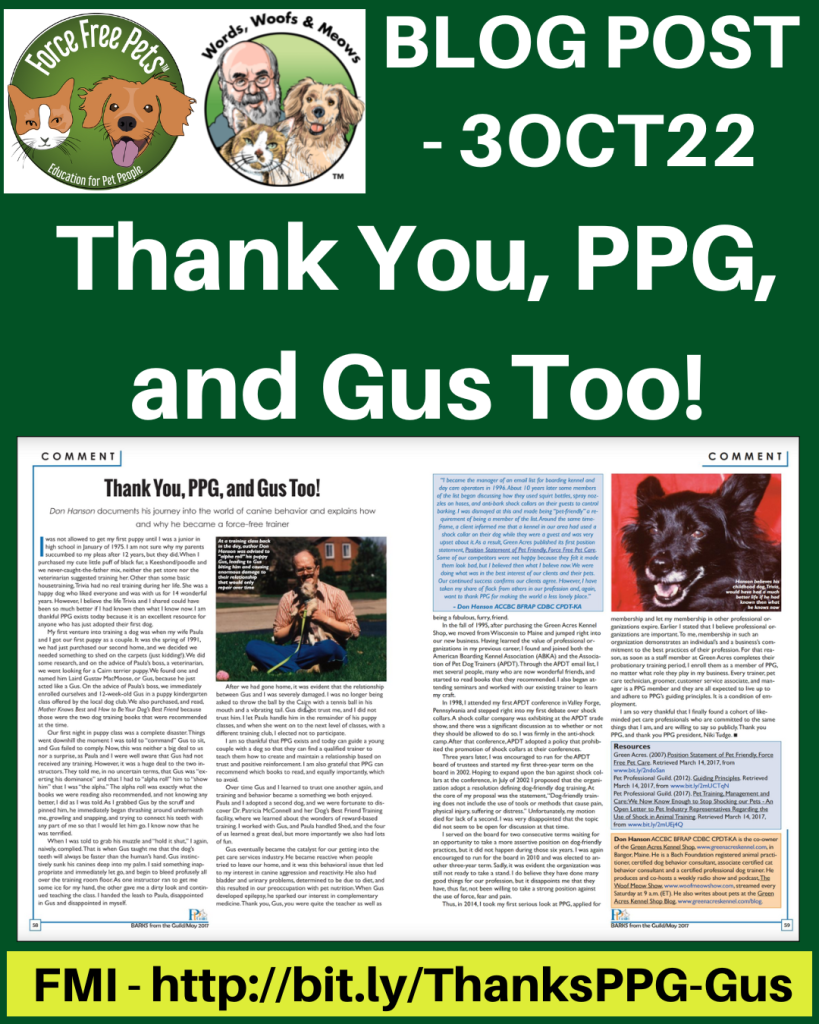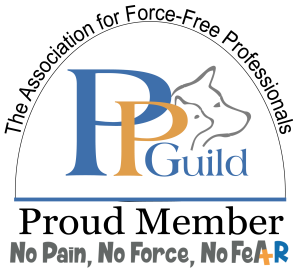By Don Hanson, PCBC-A
A version of this article was first published in the May 2017 Issue of BARKS from the Guild
< This is short link to this article on my blog
< http://bit.ly/ThanksPPG-Gus >
I was not allowed to get my first puppy until I was a junior in high school in January 1975. I am not sure why my parents succumbed to my pleas after twelve years, but they did. When I purchased my cute little puff of black fur, a Keeshond/Poodle, and we never caught the father mix, neither the pet store nor the veterinarian suggested training her. Other than some basic housetraining, Trivia had no real training 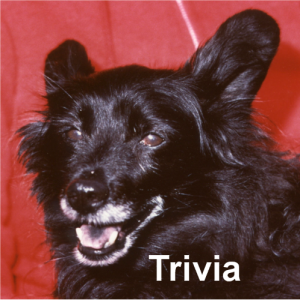 during her life. She was a happy dog who liked everyone and was with us for 14 wonderful years. However, I believe that the life Trivia and I shared could have been much better if I knew what I know now. I am thankful that PPG exists today because they are an excellent resource for anyone who has just adopted their first dog.
during her life. She was a happy dog who liked everyone and was with us for 14 wonderful years. However, I believe that the life Trivia and I shared could have been much better if I knew what I know now. I am thankful that PPG exists today because they are an excellent resource for anyone who has just adopted their first dog.
My first venture into training a dog was when my wife Paula and I got our first puppy as a couple. It was the spring of 1991, we had just purchased our second home, and we decided we needed something to shed on the carpets; just kidding! So we did some research, and on the advice of Paula’s employer, a veterinarian, we went looking for a Cairn Terrier puppy. We found one and named him Laird Gustav MacMoose or “Gus” because he just acted like a “Gus.” Then, on the advice of Paula’s boss, we immediately enrolled ourselves and twelve-week-old Gus in a

puppy kindergarten class offered by the local dog club. We also purchased and read both Mother Knows Best and How to Be Your Dog’s Best Friend because those were the two dog training books that were recommended at the time.
Our first night in puppy class was a complete disaster. First, things went downhill when I was told to command Gus to sit, and Gus failed to comply. Now, this was neither a big deal to us nor a surprise, as Paula and I knew that Gus had not received any training. However, it was a massive deal for the two instructors. In no uncertain terms, they told me that Gus was exerting his dominance and that I had to alpha-roll him to show him that I was the alpha. The alpha role was precisely what the books we were reading recommended. So not knowing any better, I did as I was told. Then, as I grabbed Gus by the scruff and pinned him, he immediately began thrashing around underneath me, growling and snapping and trying to connect his teeth with any part of me so I would let him go. I know now that he was terrified.
When I was told to grab his muzzle and “hold it shut,” I again, naively, complied. That is when Gus’ taught me that the dog’s teeth will ALWAYS be faster than the human’s hand. Gus instinctively sunk his canines deep into my palm. I said something inappropriate and immediately let go and began to bleed profusely all over the training room floor. As one instructor ran to get me some ice for my hand, the other gave me a dirty look and continued teaching the class. I handed the leash to Paula, disappointed in Gus and myself. I know now that the physical pain I experienced was nothing compared to the emotional trauma experienced by Gus.
After we went home, it was evident that the relationship between Gus and me was severely damaged. I was no longer being asked to “throw the ball” by the  Cairn with a tennis ball in his mouth and a vibrating tail. Gus did not trust me, and I did not trust him. I let Paula handle him in the remainder of his puppy classes. When she went on to the next level of classes with a different training club, I elected not to participate. I am thankful that PPG exists and today can guide a young couple with a dog to find a qualified trainer that will teach them how to create and maintain a relationship based on trust and positive reinforcement. I am grateful that PPG can also recommend which books to read and, equally important, which to avoid.
Cairn with a tennis ball in his mouth and a vibrating tail. Gus did not trust me, and I did not trust him. I let Paula handle him in the remainder of his puppy classes. When she went on to the next level of classes with a different training club, I elected not to participate. I am thankful that PPG exists and today can guide a young couple with a dog to find a qualified trainer that will teach them how to create and maintain a relationship based on trust and positive reinforcement. I am grateful that PPG can also recommend which books to read and, equally important, which to avoid.
Over time Gus and I learned to trust one another again, and training became something we both enjoyed. So when Paula and I adopted a second dog, we decided to take Gus and Shed to some additional classes. We were fortunate to discover Dr. Patricia McConnell and her Dog’s Best Friend Training facility, where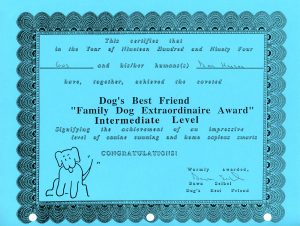 we learned about the wonders of reward-based training. I worked with Gus, and Paula handled Shed, and the four of us learned a great deal but more importantly, we also had lots of fun.
we learned about the wonders of reward-based training. I worked with Gus, and Paula handled Shed, and the four of us learned a great deal but more importantly, we also had lots of fun.
Gus eventually became the catalyst for our getting into the pet care services industry. His behavioral issues, he became reactive when people tried to leave our home, led to my interest in aggression and reactivity. His bladder and urinary problems, determined to be due to diet, resulted in our preoccupation with pet nutrition. Finally, when Gus developed epilepsy, he sparked our interest in complementary medicine. Thank you, Gus. You were quite the teacher as well as being a fabulous furry friend.
In the fall of 1995, we moved from Wisconsin to Maine after purchasing the Green Acres Kennel Shop. Paula and I jumped right into our new business. 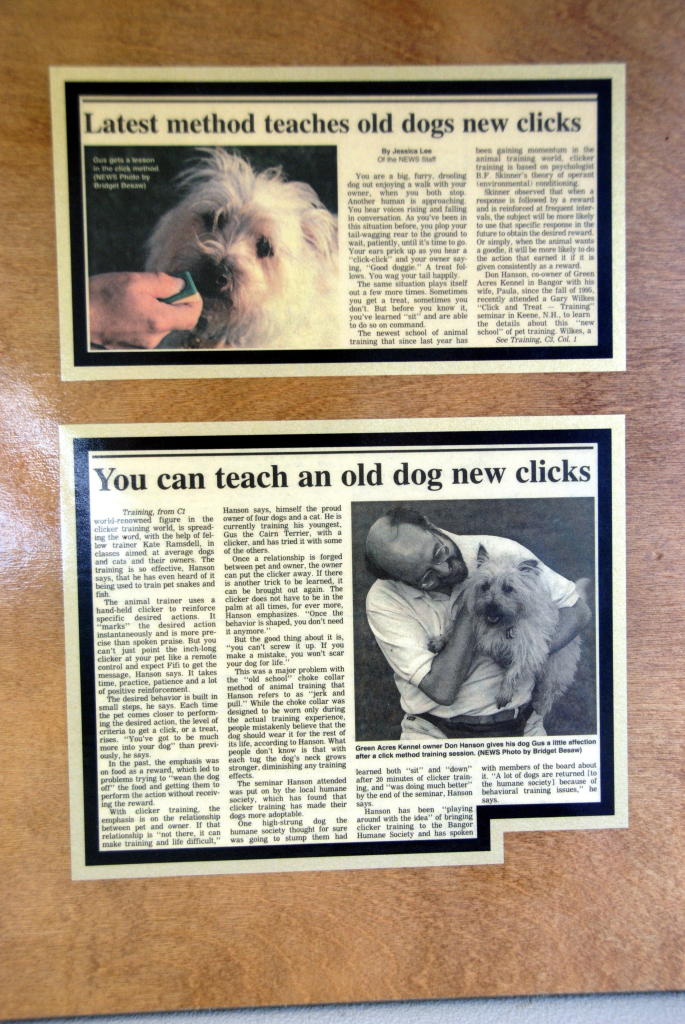 Having learned the value of professional organizations in my previous career, we discovered and joined the American Boarding Kennel Association (ABKA) and the Association of Pet Dog Trainers (APDT). Through the APDT email list, I met several people who remain close friends.
Having learned the value of professional organizations in my previous career, we discovered and joined the American Boarding Kennel Association (ABKA) and the Association of Pet Dog Trainers (APDT). Through the APDT email list, I met several people who remain close friends.
I also started reading every book I could find on dogs, behavior, husbandry, nutrition, and training. I also began attending seminars and worked with our existing trainer to learn my craft.
After attending a series of seminars on clicker training in 1997, I started working with Gus using the clicker. I sent a press release to the Bangor Daily News, which sent out a reporter to interview me. They published an article about Gus, me, and clicker training, including two photos! Immediately we were inundated with people asking about clicker training classes. I realized I had to scramble to develop those classes. Thankfully, I discovered what I believe was Dr. Deborah Jones’s first publication on clicker training, a course curriculum. In a few weeks, we started our first pilot classes, and by the end, I decided we would use the clicker in all future classes. As you can see, Gus was quite an influence.
In the fall of 1998, I attended my first APDT conference in Valley Forge, PA, and stepped right into my first debate over shock collars. A shock collar company was exhibiting at the APDT trade show, and there was a significant discussion as to whether or not they should be allowed to do so. A group of us from the APDT email list, known as the “Treat Slinging Weenies,” complete with t-shirts, expressed our displeasure. That was my first experience in advocacy in the dog world, and the experience rewarded me. After that conference, APDT adopted a policy prohibiting the promotion of shock collars at future events.
Three years later, I was encouraged to run for the APDT Board of Trustees and started my first three-year term on the Board in 2002. Hoping to expand upon the ban on promoting shock collars at the conference,e in July of 2002, I proposed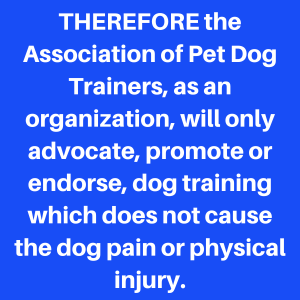 that the APDT adopt a resolution defining dog-friendly dog training. At the time, the term “dog-friendly” was used in both the APDT Vision and Mission statements.
that the APDT adopt a resolution defining dog-friendly dog training. At the time, the term “dog-friendly” was used in both the APDT Vision and Mission statements.
I based my resolution to clarify what APDT meant by “dog-friendly on a position by the World Small Animal Veterinary Association WSAVA stating, “No companion animal should be trained in such a way that is detrimental to its health and welfare, especially by methods which force it to exceed its natural capacities or strength by employing artificial training aids which may cause physical injury, pain, suffering or distress.” Since a survey of the APDT membership indicated that 65% of the members responding believed that APDT should advocate only positive training approaches, and 57% of the respondents believed APDT should NOT be impartial toward training methods. I naively thought the adoption of my proposal would be a “No Brainer.”
My proposal ended by stating, “THEREFORE, it is only logical to conclude that “dog friendly-training” does not include the use of tools or methods that are intended to cause pain or physical injury and that a majority of the membership support this conclusion. And THEREFORE, the Association of Pet Dog Trainers, as an organization, will only advocate, promote or endorse, dog training which does not cause the dog pain or physical injury.” Sadly, my motion died for lack of a second. I was very disappointed that no one was willing to discuss my proposal.
I served on the APDT Board for two consecutive terms waiting for an opportunity to get APDT to take a more assertive position on dog-friendly practices. Still, it never happened during those six years. I was again encouraged to run for the Board in 2010 and was elected to another three-year term. Sadly, it was evident the APDT was still not ready to take a stand on the use of aversives.
In 2014 I took my first serious look at PPG, applied for membership, and let my membership in the APDT expire. Earlier I stated that I believe professional organizations are essential. To me, membership in such an organization demonstrates an individual’s and a business’s commitment to the best practices of their profession. For that reason, as soon as a team member at Green Acres or ForceFreePets completes their probationary training period, I enroll them as a member of the PPG no matter what role they play here. Every trainer, pet care technician, groomer, customer service associate, and manager is a PPG member and is expected to live up to the PPG guiding principles. It is a condition of employment.
I am very thankful that I finally found a cohort of like-minded pet care professionals committed to the same things I am and their willingness to support those beliefs publicly. Thank you, PPG, and thank you, Niki Tudge.
I continue to believe that it is necessary to advocate for the humane treatment of pets by all pet care professionals. I became an email list manager for a group of boarding kennel and daycare operators in 1996. In 2006, some members of the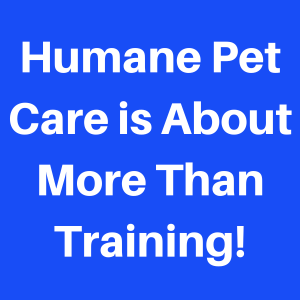 list began discussing how they used squirt bottles, spray nozzles on hoses, and anti-bark shock collars on their guests to control barking. I was appalled and made being pet-friendly a requirement of being a member of the list. Around the same time, a client informed me that a kennel in our area used a shock collar on their dog while the dog was in the care of the facility. This was something the dog’s owners would never have approved, and they were rightfully very upset.
list began discussing how they used squirt bottles, spray nozzles on hoses, and anti-bark shock collars on their guests to control barking. I was appalled and made being pet-friendly a requirement of being a member of the list. Around the same time, a client informed me that a kennel in our area used a shock collar on their dog while the dog was in the care of the facility. This was something the dog’s owners would never have approved, and they were rightfully very upset.
As a result, I decided Green Acres Kennel Shop needed to be proactive about stating precisely what we mean by “Pet Friendly.” As a result, we published our first position statement entitled “Green Acres Is A “Pet-Friendly Facility” (https://www.greenacreskennel.com/blog/2006/02/01/green-acres-first-statement-on-being-a-pet-friendly-facility/) in February of 2002.
In the Spring of 2022, we took another step forward in the goal of a world where all pet care professionals are humane, ethical, and transparent in their policies 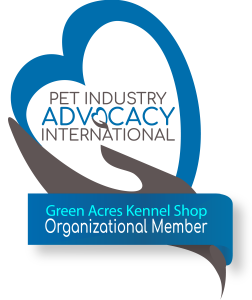 and practices by applying to become an organizational member of Pet Industry Advocacy International (PIAI). Membership in PIAI is open to any pet professional organization that currently practices and advocates for ethical, humane science-based services that have been in business for at least three years and have a minimum of ten members/employees/volunteers. Green Acres Kennel Shop is the first boarding, daycare, and grooming facility to be accepted by PIAI. I encourage all eligible organizations and facilities to become PIAI members as it’s what pets need and what most people with pets, expect of those caring for their pets.
and practices by applying to become an organizational member of Pet Industry Advocacy International (PIAI). Membership in PIAI is open to any pet professional organization that currently practices and advocates for ethical, humane science-based services that have been in business for at least three years and have a minimum of ten members/employees/volunteers. Green Acres Kennel Shop is the first boarding, daycare, and grooming facility to be accepted by PIAI. I encourage all eligible organizations and facilities to become PIAI members as it’s what pets need and what most people with pets, expect of those caring for their pets.
Resources
Green Acres’ First Statement on Being A Pet Friendly-Facility – http://blog.greenacreskennel.com/2006/02/01/green-acres-first-statement-on-being-a-pet-friendly-facility/
Green Acres Kennel Shop Position Statement on Pet-Friendly, Force-Free Pet Care – http://bit.ly/GAKS_Pet-Friendly
Green Acres Kennel Shop Position on the Use of Dominance and Punishment for the Training and Behavior Modification of Dogs – http://bit.ly/GAKS-Pos-NoPain-NoForceNoFear
Pet Professional Guild Guiding Principles – http://www.bit.ly/2mUCTqN
Pet Professional Guild – Pet Training, Management and Care: We Now Know Enough to Stop Shocking Our Pets – An Open Letter to Pet Industry Representatives Regarding the Use of Shock in Animal Training – http://bit.ly/2mUEj4Q
Things I Wish I Had Known Before I Started Training Dogs – Gus, the Dominance Myth, An Alpha Roll, and a Damaged Relationship – http://bit.ly/Things-Gus-Dominance
Dominance: Reality or Myth – http://bit.ly/Dominance-RealityorMyth
________________________________________________________________________
Don Hanson lives in Bangor, Maine, where he is the co-owner of the Green Acres Kennel Shop ( greenacreskennel.com ) and the founder of ForceFreePets.com, an  online educational resource for people with dogs and cats. He is a Professional Canine Behavior Consultant (PCBC-A) accredited by the Pet Professional Accreditation Board (PPAB) and a Bach Foundation Registered Animal Practitioner (BFRAP). Don is a member of the Pet Professional Guild (PPG), serving on the Board of Directors and Steering Committee and chairing the Advocacy Division. He is also a founding director of Pet Advocacy International (PIAI). In addition, Don produces and co-hosts The Woof Meow Show podcast, available at http://bit.ly/WfMwPodcasts/, the Apple Podcast app, and Don’s blog: www.words-woofs-meows.com. The opinions in this article are those of Don Hanson.
online educational resource for people with dogs and cats. He is a Professional Canine Behavior Consultant (PCBC-A) accredited by the Pet Professional Accreditation Board (PPAB) and a Bach Foundation Registered Animal Practitioner (BFRAP). Don is a member of the Pet Professional Guild (PPG), serving on the Board of Directors and Steering Committee and chairing the Advocacy Division. He is also a founding director of Pet Advocacy International (PIAI). In addition, Don produces and co-hosts The Woof Meow Show podcast, available at http://bit.ly/WfMwPodcasts/, the Apple Podcast app, and Don’s blog: www.words-woofs-meows.com. The opinions in this article are those of Don Hanson.
©3OCT22, Donald J. Hanson, All Rights Reserved
< Click for Copyright and Use Policy >
